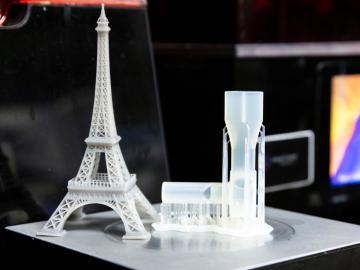Filter News
Area of Research
- (-) Clean Energy (168)
- (-) Fusion and Fission (32)
- (-) Materials (122)
- Advanced Manufacturing (5)
- Biological Systems (1)
- Biology and Environment (102)
- Biology and Soft Matter (4)
- Building Technologies (2)
- Chemical and Engineering Materials (3)
- Chemistry and Physics at Interfaces (7)
- Climate and Environmental Systems (7)
- Computational Biology (1)
- Computational Chemistry (5)
- Computational Engineering (1)
- Computer Science (3)
- Data (1)
- Earth Sciences (1)
- Electricity and Smart Grid (1)
- Energy Frontier Research Centers (7)
- Fuel Cycle Science and Technology (2)
- Functional Materials for Energy (8)
- Fusion Energy (7)
- Geographic Information Science and Technology (1)
- Isotopes (21)
- Materials for Computing (13)
- Materials Synthesis from Atoms to Systems (8)
- Materials Under Extremes (7)
- National Security (45)
- Neutron Data Analysis and Visualization (2)
- Neutron Science (72)
- Nuclear Science and Technology (27)
- Quantum Condensed Matter (3)
- Quantum information Science (4)
- Renewable Energy (2)
- Sensors and Controls (2)
- Supercomputing (153)
- Transportation Systems (4)
News Type
News Topics
- 3-D Printing/Advanced Manufacturing (25)
- Advanced Reactors (3)
- Artificial Intelligence (6)
- Big Data (2)
- Bioenergy (11)
- Biology (4)
- Biomedical (4)
- Biotechnology (1)
- Buildings (11)
- Chemical Sciences (9)
- Clean Water (5)
- Climate Change (8)
- Composites (3)
- Computer Science (13)
- Coronavirus (6)
- Cybersecurity (6)
- Decarbonization (16)
- Energy Storage (22)
- Environment (24)
- Exascale Computing (2)
- Fossil Energy (1)
- Frontier (1)
- Fusion (14)
- Grid (13)
- High-Performance Computing (4)
- Isotopes (6)
- ITER (2)
- Machine Learning (2)
- Materials (24)
- Materials Science (20)
- Mathematics (2)
- Mercury (1)
- Microelectronics (1)
- Microscopy (8)
- Nanotechnology (9)
- National Security (1)
- Net Zero (2)
- Neutron Science (11)
- Nuclear Energy (26)
- Partnerships (5)
- Physics (12)
- Polymers (4)
- Quantum Computing (1)
- Quantum Science (1)
- Security (4)
- Simulation (3)
- Space Exploration (2)
- Summit (3)
- Sustainable Energy (17)
- Transformational Challenge Reactor (2)
- Transportation (20)
Media Contacts

Carl Dukes’ career as an adept communicator got off to a slow start: He was about 5 years old when he spoke for the first time. “I’ve been making up for lost time ever since,” joked Dukes, a technical professional at the Department of Energy’s Oak Ridge National Laboratory.

ORNL is leading two nuclear physics research projects within the Scientific Discovery through Advanced Computing, or SciDAC, program from the Department of Energy Office of Science.

Speakers, scientific workshops, speed networking, a student poster showcase and more energized the Annual User Meeting of the Department of Energy’s Center for Nanophase Materials Sciences, or CNMS, Aug. 7-10, near Market Square in downtown Knoxville, Tennessee.

Researchers at ORNL are developing advanced automation techniques for desalination and water treatment plants, enabling them to save energy while providing affordable drinking water to small, parched communities without high-quality water supplies.

Cadet Elyse Wages, a rising junior at the United States Air Force Academy, visited ORNL with one goal in mind: collect air.

Researchers at the Department of Energy’s Oak Ridge National Laboratory have created a new detection system that allows home energy auditors to see air leaking from a building in real time with the help of a camera.

Michelle Kidder, a senior R&D staff scientist at ORNL, has received the American Chemical Society’s Energy and Fuels Division’s Mid-Career Award for sustained and distinguished contributions to the field of energy and fuel chemistry.

Subho Mukherjee, an R&D associate in the Vehicle Power Electronics Research group at the Department of Energy’s Oak Ridge National Laboratory, has been elevated to the grade of senior member of the Institute of Electrical and Electronics Engineers.

Rose Montgomery, a distinguished researcher and leader of the Used Fuel and Nuclear Material Disposition group at ORNL, has been selected to participate in the U.S. WIN Nuclear Executives of Tomorrow, or NEXT, class of 2023 to 2024.

Autonomous labs are changing the nature of scientific investigation. Instead of humans manually orchestrating every part of an experiment, programmed equipment can carry out necessary functions. This workflow accelerates the pace of discovery by reducing the number of monotonous tasks that researchers must perform.




